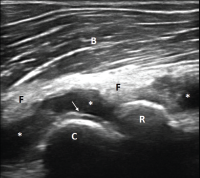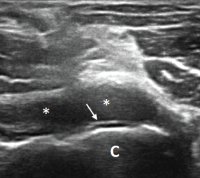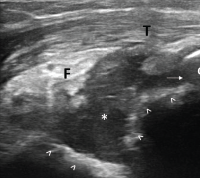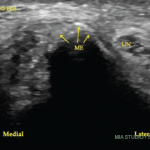
Figure 1. Ultrasound of the left elbow: anterior humero-radial longitudinal view. A large anechoic to hypoechoic collection (*) is present in the anterior elbow joint, which superiorly displaces the fatpad (F) and the brachialis muscle (B). This collection extends proximal to the humeral capitellum (C) into the radial fossa (left sided *) and distal to the radial head (R) to the annual recess (right sided *). There is a hyperechoic linear band (arrow) over the superficial margin of the hyaline cartilage of the humeral capitellum.

Figure 2. Ultrasound of the left elbow: anterior transverse view of the radial aspect of the joint. A large anechoic collection (*) is present in the anterior radial joint space. There is a hyperechoic linear band (arrow) over the superficial margin of the hyaline cartilage of the humeral capitellum (C).

Figure 3. Ultrasound of the left elbow: posterior longitudinal view. There is a large, anechoic to hypoechoic collection deep to the triceps muscle (T) in the olecranon fossa (*) and posterior elbow joint recess (arrow), which superiorly displaces the posterior fatpad (F). For landmarks, note the olecranon process (O), the humeral trochlea (arrows).
Diagnostic Pearls
In this patient’s multidisciplinary evaluation, we bring up two diagnostic pearls.
First, the abnormal lymphocytes aspirated from the patient’s elbow joint suggest synovial infiltration by lymphomatous cells. This is a very rare complication of lymphoma/leukemia, but should be considered in patients with adult T cell leukemia/lymphoma (ATLL) with acute joint effusion.
A prior case features a patient with HTLV-1 infection and ATLL who developed polyarthritis and malignant synovial infiltration, and responded to radiation, steroids and targeted immunomodulatory therapy.1
A handful of other cases of HTLV-1-associated ATLL with lymphomatous synovial infiltration have also been described.2-4 In these cases, synovial fluid cytology and flow cytometry confirmed presence of malignant cells with CD3, CD4 and T cell receptor profiles consistent with those in the peripheral blood, lymph node biopsies and other systemic sites.3,4 Unfortunately, our patient developed intractable disease and moved to hospice prior to full diagnostic confirmation of synovial fluid flow cytometry.
Second, we would like to focus on the sonographic double contour sign, which is created by deposition of uric acid crystals on the surface of the hyaline cartilage. The DC sign is defined by OMERACT as a hyperechoic band over the superficial margin of the articular hyaline cartilage that can be continuous or intermittent, regular or irregular and is independent of the angle of insonation (the angle of the ultrasound beam).5

